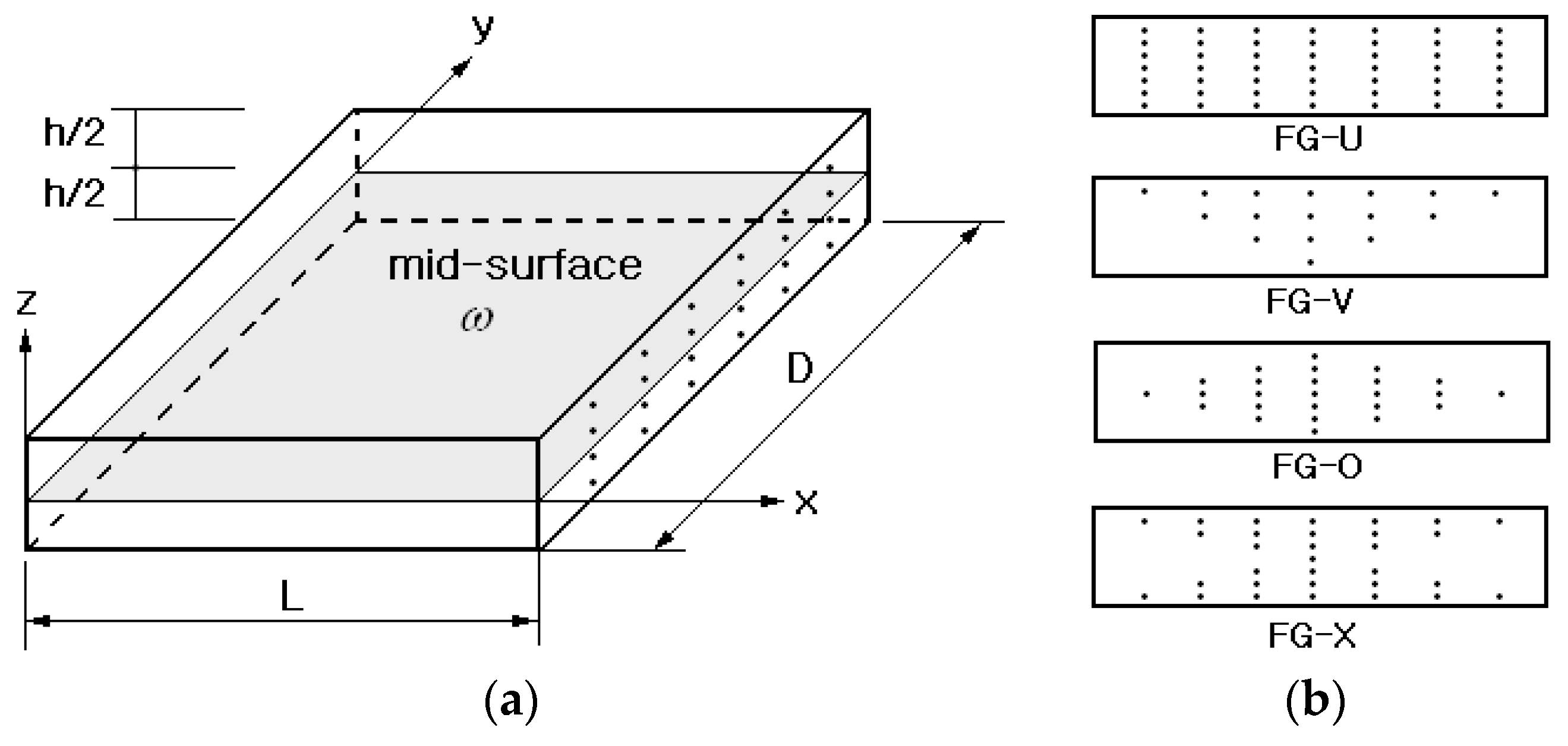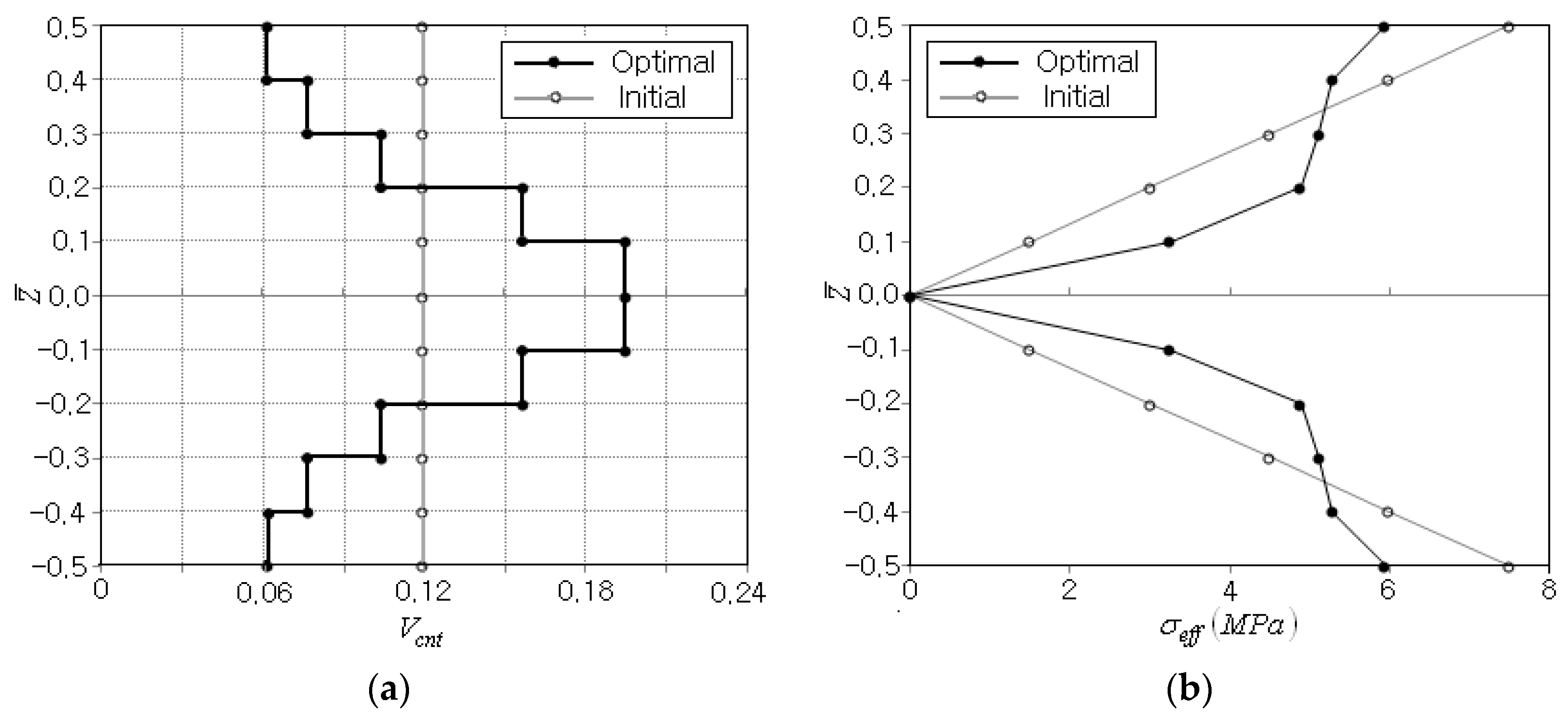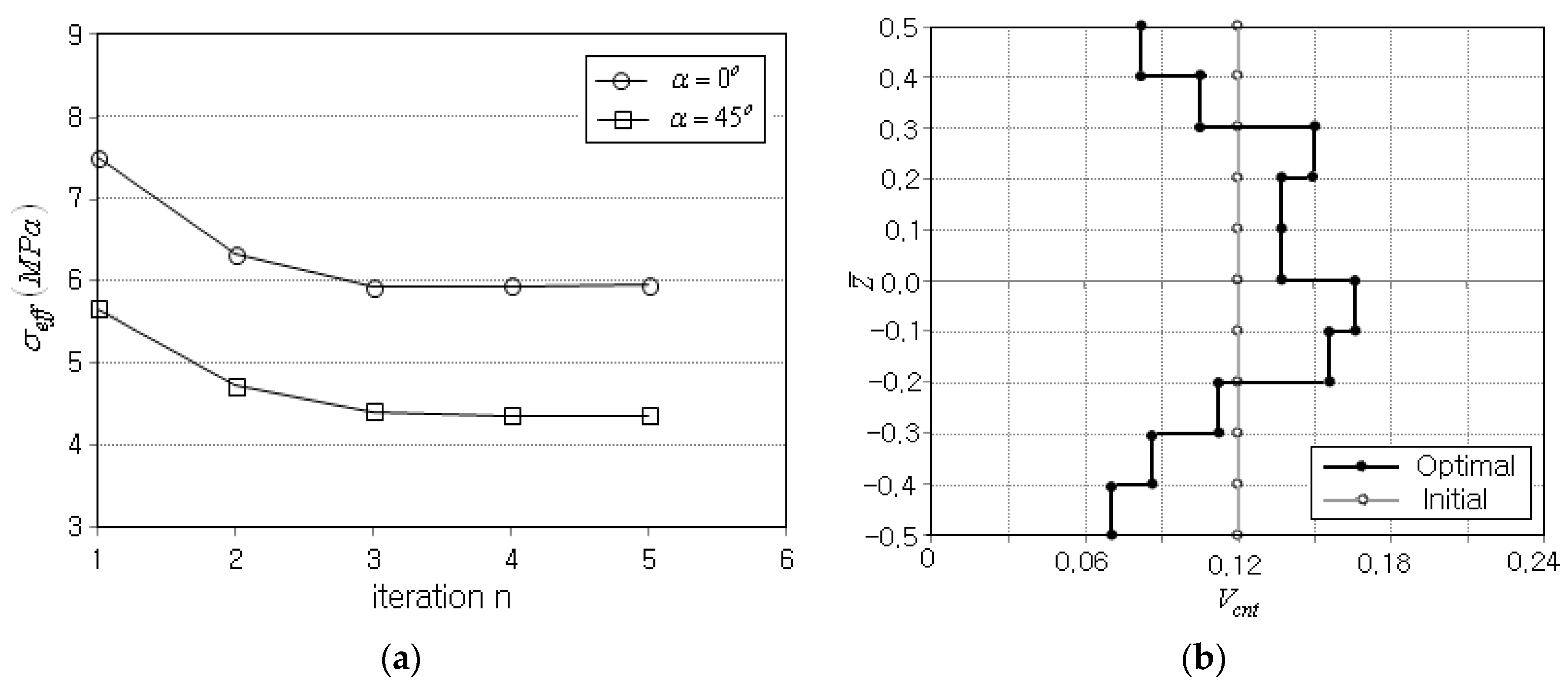1. Introduction
Carbon nanotube (CNT) has been spotlighted as a state-of-art material of the 21st century due to its excellent physical, electrical and chemical properties [
1,
2]. A representative quality is the high weight–stiffness ratio, so that CNTs can be used as a next-generation pillar for polymer-matrix composites. In fact, the mechanical strength of the CNT-reinforced polymer composite dramatically increases when only a small amount of CNTs are inserted [
3]. In mechanical applications, CNTRCs have been developed in the form of beams, plates and shells, because these are used as ingredient components in a variety of engineering applications. When compared with the conventional composites, CNTRCs provide superior mechanical behaviors, such as bending deformation, free vibration and buckling [
4,
5,
6].
Meanwhile, the above-mentioned structural components exhibit variations in their mechanical behaviors through their thickness, so that the uniform thickness-wise distribution of CNTs may not be sufficient to respond to such variations. It has been reported that the improvement in the mechanical behavior of CNTRCs is limited when CNTs are uniformly distributed [
7,
8]. To resolve this limitation, the functional gradient in the thickness-wise CNT distribution was introduced according to the concept of functionally graded material (FGM) [
9]. Shen [
10] and Ke et al. [
11] proposed a purposeful thickness-wise CNT distribution within CNTRCs to suppress bending deformation and control the free vibration. Thereafter, the CNT-reinforced composites with purposeful thickness-wise CNT distributions were called functionally graded CNT-reinforced composites (FG-CNTRCs). The representative FG-CNTRCs include FG-U, FG-V, FG-O and FG-X, in which CNTs are distributed through the thickness with the purposeful linear gradients. The dispersion of CNTs into a polymer matrix can be carried out by the spark plasma-sintering process, the powder metallurgy (PM) route and chemical vapor deposition. The reader may refer to [
12,
13,
14] for more details on the manufacturing of CNT-reinforced composites.
Since their introduction, extensive research efforts have focused on FG-CNTRCs to investigate their mechanical behaviors, particularly the parametric investigation with respect to the thickness-wise distribution pattern of CNTs. For example, Zhu et al. [
15] and Cho and Ahn [
3] numerically investigated the influence of CNT distribution pattern on the bending deformation and the natural frequencies of FG-CNTRC plates using finite and natural element methods. Cheshmeh et al. [
16] investigated the buckling and vibration behaviors of FG-CNTRC plate with respect to the CNT distribution pattern and the CNT volume fraction using the higher-order shear deformation theory. Zhong et al. [
17] investigated the free vibration of FG-CNTRC circular and annular plates with arbitrary boundary conditions with respect to the CNT distribution pattern. Xiang et al. [
18] numerically investigated the free vibration of FG-CNTRC conical shell panels with respect to the CNT distribution pattern, as well as the key design parameters using the Ritz element-free method. Mirzaei and Kiani [
19] analytically investigated the influence of the CNT distribution pattern on the thermal buckling of FG-CNTRC conical shells. Thai et al. [
20] proposed a NURBS formulation based on the four-variable refined plate theory for free vibration, buckling and bending analyses of multilayer FG-CNTRC plates. Civalek et al. [
21] investigated the free vibration and buckling behaviors of FG-CNT-reinforced cross-ply laminated composite plates using an FSDT and a discrete singular convolution (DSC) method. Mohammadimehr et al. [
22] analyzed the buckling and free vibration of double-bonded micro-composite sandwich plates based on the most general strain gradient theories (MGSGT) under electro–magneto–thermo–mechanical and pre-stress loadings. Wu et al. [
23,
24] investigated the geometrical imperfection sensitivity of postbuckling of FG-CNTRC and piezoelectric FG-CNTRC beams using the first-order shear deformation (FSD) beam theory with von-Kármán nonliearity. Zaghloul et al. [
25,
26] studied the fatigue and tensile behaviors of polymer composites filled with nanoparticles and presented an experimental and modeling analysis of their mechanical–electrical behaviors. The review papers by Liew et al. [
27] and Zaghloul and Zagghloul [
14] may be referred to for a broader literature survey of FG-CNTRC structures.
As can be realized from the above literature survey, most studies focused on the parametric investigation of FG-CNTRC structures with respect to the CNT distribution pattern. This parametric study can provide a guideline for choosing a suitable one from the above-mentioned primitive CNT distribution patterns. Nevertheless, this approach can only be called a passive one because the most suitable CNT distribution pattern for the FG-CNTRC under consideration is problem-dependent, as the mechanical behavior of FG-CNTRC is definitely influenced by the structure geometry and the loading/boundary conditions. In this situation, an active approach to tailoring a best thickness-wise CNT distribution pattern, which can maximize the target performance, is required for the successful application of FG-CNTRC structures. Inspired by this situation, the present paper introduces a numerical method for optimally tailoring the thickness-wise CNT distribution pattern for FG-CNTRC structures.
As a preliminary stage, the static bending of FG-CNTRC beam is considered and the optimization problem is defined by minimizing the effective stress. The CNT distribution in the FG-CNTRC beam varies continuously and smoothly throughout the thickness, so the definition of design variables should be considered. In the current work, an FG-CNTRC beam is divided into several sub-layers with uniform CNT distributions in order to minimize the total number of design variables and maintain the flexibility of CNT distribution through the thickness. Then, the CNT volume fractions of each sub-layer become the design variables and their arithmetic sum should satisfy the preset entire CNT volume fraction. The constrained numerical optimization is formulated by employing the exterior penalty-function method, and the sensitivity of objective function to the design variable vector is evaluated using the central difference scheme. The proposed numerical optimization method is validated through the benchmark examples, and the optimum CNT distributions and the associated stress distributions are investigated with respect to the loading condition and compared with those of conventional CNT distribution patterns. The numerical experiments confirmed that the present optimization method successfully seeks the optimum CNT distribution, which provides the minimum effective stress.
The paper is organized as follows: FG-CNTRC structures are introduced in
Section 2, together with the CNT volume fraction distribution and the effective material properties. The numerical formulations for the finite-element static analysis and the CNT distribution optimization are addressed in
Section 3. The optimization results are presented in
Section 4, together with the discussion, and the final conclusion is given in
Section 5.
2. Modeling of Functionally Graded CNT-Reinforced Composites
Figure 1a shows a typical CNT-reinforced rectangular composite in which single-walled CNTs (SWCNTs) are functionally distributed through the thickness within a polymer matrix. The carbon nanotubes are inserted such that their axes direct to the
–direction, and the composite has the length
, the depth
and the thickness
. The distribution of CNT through the thickness has a functional gradient as shown in
Figure 1b, where four types of functionally graded CNTRCs are depicted: FG-U, FG-V, FG-O and FG-X. Since FG-CNTRCs are sort of dual-phase composite, their effective mechanical properties can be determined using the approximate method [
9,
28] such as the rule of mixture or the Mori–Tanaka estimate. For the current study, the modified linear rule of mixtures (LRM) is used by introducing the CNT efficiency parameters
.
According to the modified LRM, the effective elastic moduli and the effective shear modulus are calculated as [
10]
in which
and
denote the volume fractions of CNTs and polymer which are in function of
. In Equations (1)–(3), the scripts
and
are used to denote the properties of SWCNT and polymer matrix. The polymer matrix is assumed to be homogeneous and isotropic while SWCTs are modeled as an orthotropic material, and, furthermore, it is assumed that
and
. The scale dependence of the effective material properties of CNTRCs is reflected through the CNT efficiency parameters
[
29]. These parameters were obtained by matching the effective CNTRC properties predicted by the molecular dynamics (MD) simulation with those estimated by LRM.
Table 1 presents the CNT efficiency parameters for a poly(methyl methacrylate) (PMMA) matrix with CNTs reinforcement at room temperature.
The volume fraction functions of CNTs in the above four FG-CNTRCs through the thickness are expressed by
Here, the total volume fraction
of CNTs contained within the polymer matrix is calculated from the CNT mass fraction
such that
with
and
being the densities of CNTs and the polymer matrix.
Meanwhile, the effective Poisson’s ratio
and the effective density
are determined in a similar manner
Considering the FG-CNTRCs as a 3-D orthotropic body occupying a bounded domain
, its displacement field
under the action of body force
and external load
is governed by
with the boundary conditions:
Here, and denote the displacement and force boundaries, and and are the stress components and the unit normal vector, respectively.
4. Results and Discussion
Figure 4a represents the first model problem, a simpply supported FG-CNTRC beam subject to uniform distributed load
. The length
is
and the depth
and the thickness
are equally set by
, respectively. The matrix is manufactured with poly(methyl methacrylate) (PMMA) and its isotropic material properties are given in
Table 2, where the orthotropic material properties of the (10,10) SWCNTs are also presented. The FG-CNTRC beam is divided into 10 uniform sub-layers with layer-wise CNT volume fractions
, as represented in
Figure 4b, in order to suppress the increase in the total number of design variables by considering the flexibility of thickness-wise CNT distribution at the same time. For the finite element structural analysis, each sub-layer is discretized into
uniform 8-node cubic elements, with 100 in the
-direction and 10 in the
-direction. Therefore, the total number of finite elements for the whole FG-CNTRC beam reaches 10,000.
The initial CNT volume fractions
of ten sub-layers are set by the preset total CNT volume fraction
. For example, the initial layer-wise CNT volume fractions
are equally designated by 0.12 when the preset value of
is 0.12. The convergence tolerance
in Equation (34) is set by
and the initial penalty parameter
and the update constant
in Equation (35) are taken by 1.0 and 2.0, respectively. Since this problem exhibits a remarkable edge effect in the bending stress field near the left and right ends of beam, the peak stress value is examined from the thickness-wise stress distribution at the beam mid-span (i.e., at
). The finite element analysis was carried out by midas NFX [
31], a commercial FEM software.
For the preset CNT volume fraction
, the optimization process terminates after five iterations, as shown in
Table 3. The peak effective stress occurs at the top and bottom of beam, and 311 FEM analyses were performed, mostly for the sensitivity analysis.
Table 3 shows that the objective function uniformly decreases proportionally to the iteration number. The peak effective stress
is
at the initial stage and
at the final stage, so that it is reduced by
, which corresponds to 20.7% of the initial peak effective stress.
Figure 5a compares the initial and optimum CNT distributions, where the layer-wise CNT volume fractions
are larger than 0 and less than 1.0 and their sum is found to be 11.95. Hence, it is confirmed that the equality constraint in Equation (27) and the inequality constraints in Equations (28) and (29) are strictly enforced.
Figure 5b compares the thickness-wise effective stress distributions between the initial and optimum CNT distributions, where the initial one varies linearly from zero at the mid-surface to the peak value at the top and bottom. The optimum one is also zero at the mid-surface and symmetric with respect to the mid-surface, but is not linear any longer and its peak is smaller than that of the initial one. In the bending deformation, the bending strain exhibits a linear thickness-wise variation, which produces the linear bending stress distribution through the thickness when the elastic modulus is uniform. However, the parabolic-type optimum CNT distribution leads to the parabolic-type distribution of elastic modulus of FG-CNTRC beam, so that the non-linear stress distribution with the smaller peak effective stress is revealed.
The optimization is also performed for two different CNT volume fractions,
and 0.28, and the optimization results are compared in
Table 4. The total iteration numbers are similar, but the total numbers of FE analyses are different. It is presumed that the sensitivity analysis is influenced by the value of
. The peak effective stresses occur at the top and bottom of beam for all the three cases, and the initial and optimum peak effective stresses are similar. Thus, it is found that the influence of the total CNT volume fraction
on the CNT distribution optimization for minimizing the peak effective stress is not significant.
Figure 6a comparatively represents the optimum CNT distributions for three different values of
. It can be seen that three optimum CNT distributions are commonly parabolic-type and show different layer-wise CNT volume fractions
to fulfill the equality constraint imposed upon
.
Figure 6b compares the effective stress distributions between three different values of
, where it is observed that the difference between three distributions is not significant. Thus, it is again confirmedthat the total CNT volume fraction
does not impose any significant influence on the stress results.
Next, the thickness-wise stress distribution for the optimum CNT distribution when
is 0.12 is compared with those of four standard functionally graded CNT distributions, FG-U, FG-V, FG-O and FG-X. The results are presented in
Table 5, where
indicates the difference in
between the optimum and FG CNT distributions and the values within parenthesis denote the relative differences with respect to the optimum stress. It is found that
is lowest for the optimum case, while this is the highest for FG-V. Thus, it has been justified that the present optimization method successfully seeks the optimum CNT distribution, which can provide the maximum effective stress, which is smaller than those of standard FG CNT distributions.
This fact is well represented in
Figure 7a, where FG-V shows an unsymmetric effective stress distribution with the highest
at the top of the beam because its CNT distribution is unsymmetric, as shown in
Figure 1b. Meanwhile, FG-O produces the peak effective stress at
in accordance with its CNT distribution. Furthermore, its peak effective stress is higher than that of FG-U even though its CNT distribution is similar to the optimum CNT distribution. For the sake of comparison, the axial stress distributions are comparatively represented in
Figure 7b, to examine whether there is a remarkable difference between the effective stress, which is calculated by all six stress components, and a single bending stress component. Since the axial stress is the dominant stress component in the current bending deformation problem, the axial stress distributions are observed to be similar to the effective stress distributions, except for the minus sign in the upper-half region.
Next, the optimization was performed again for the previous simply supported beam by inclining the distributed load. Referring to
Figure 4a, the vertical distributed load was inclined by
with respect to the
-axis. However, except for this inclined distributed load, the beam geometry and the simulation parameters were kept the same as the previous case. The layer-wise CNT volume fractions
were initially set by 0.12, and the numerical optimization terminates in five iterations, as presented in
Table 6. When compared with the previous case, the total number of FEM analyses was smaller and the location of peak effective stress was fixed at the bottom. The peak effective stress
ws
at the initial stage and
at the final stage, being reduced by
, which is 23.7% of the initial peak effective stress.
Figure 8a compares the iteration histories of objective function between the previous and current cases, where both cases produce a difference in effective stress magnitude but commonly show rapid and stable convergence.
Figure 8b comparatively represents the initial and optimum CNT distributions, where the arithmetic sum of layer-wise CNT volume fractions
was found to be 12.08. Thus, the preset CNT volume fraction
is strictly satisfied. Meanwhile, the current optimum CNT distribution was seen to be asymmetric, differing from the previous one shown in
Figure 5a. This is because the inclined distributed load produces the asymmetric effective stress distribution, as will be seen below. Thus, it has been found that the optimum thickness-wise CNT distribution is significantly influenced by the loading condition. Additionally, this asymmetric CNT distribution cannot be tailored, even though the conventional primitive CNT distribution patterns shown in
Figure 1b are combined.
Figure 9a comparatively represents the axial stress distributions of the initial and optimum CNT distributions. Differing from the previous case shown in
Figure 7b, the axial stress in the present case does not vanish at the mid-surface. In other words, the zero-line moves slightly upwards because the inclined load not only produces the bending deformation but also the axial extension. Thus, the initial axial stress distribution is not symmetric but asymmetric with respect to the mid-surface. The optimum axial stress distribution becomes more asymmetric because the optimum CNT distribution is additionally asymmetric, as shown in
Figure 8b.
Figure 9b compares the thickness-wise effective stress distributions between the initial and optimum CNT distributions, where both the initial and optimum CNT distributions show higher peak effective stresses at the bottom because the inclined distributed load produces additional tensile stress. When compared with the previous case shown in
Figure 5b, the present inclined load leads to a remarkably different effective stress distribution. The effective stress does not vanish near the mid-surface because the shear stress caused by the inclined distributed load is not negligible. Hence, it is found that not only the optimum CNT distribution, but also the resulting stress distribution, is strongly influenced by the loading condition.
















